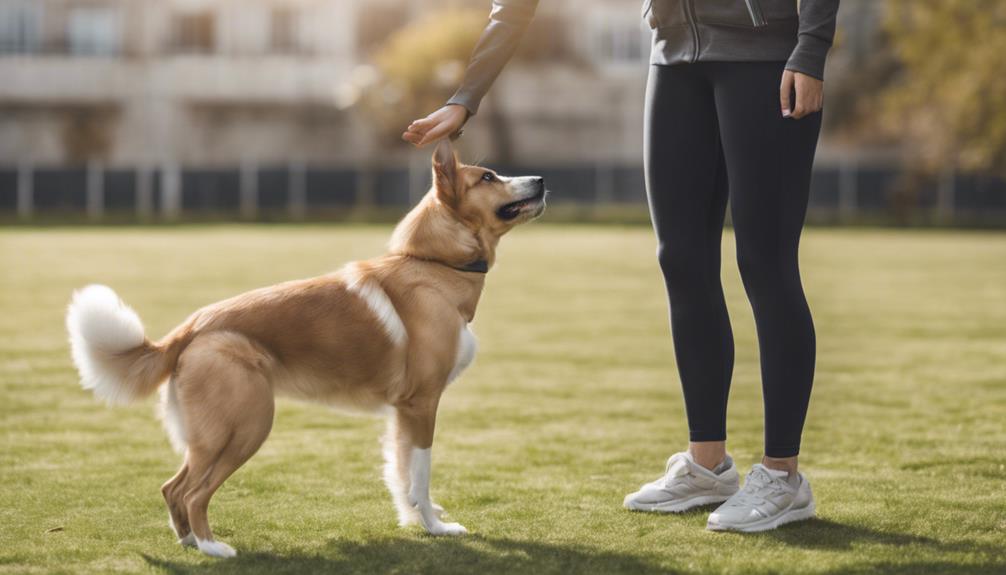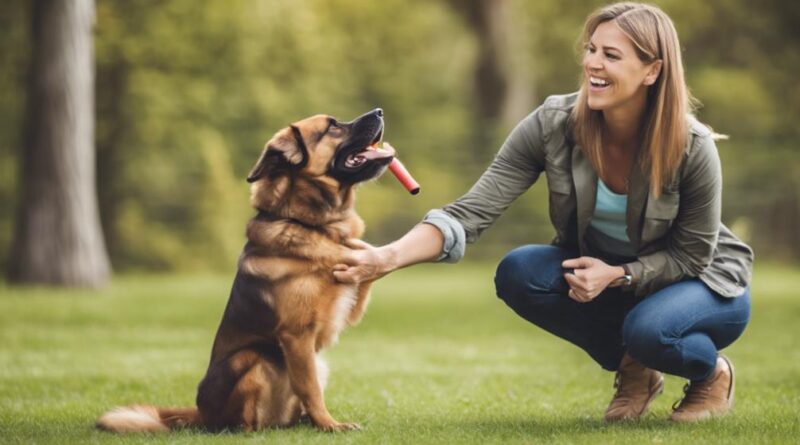Why Is Psychology Crucial in Dog Training?
Imagine dog training as a complex puzzle; without understanding the intricacies of a canine's mind, you may struggle to piece together a successful training regimen. Psychology serves as the key to unlocking your dog's potential and fostering a strong relationship with your furry companion.
By exploring the depths of canine behavior, you can tap into a world where communication is beyond words and commands. The bond you share with your dog is a multifaceted connection that thrives on psychological insights. This connection can elevate your training sessions from mundane routines to transformative experiences that enrich both your lives.
Understanding Canine Behavior
Understanding canine behavior is crucial for effective dog training. Canine instincts play a significant role in how dogs behave and interact with their environment. By recognizing and understanding these instincts, such as their pack mentality or prey drive, you can tailor your training methods to better suit your dog's natural inclinations.
Behavioral patterns also play a vital role in training. Dogs often exhibit consistent behaviors in response to certain stimuli, and by observing and interpreting these patterns, you can anticipate your dog's reactions and adjust your training approach accordingly. For example, if your dog displays fear-based aggression in specific situations, understanding this behavioral pattern can help you address the root cause and work on desensitization training.
Importance of Positive Reinforcement
Recognizing the significance of positive reinforcement in dog training is key to fostering desired behaviors in your canine companion. When it comes to training your furry friend, here are three crucial points to consider:
- Reward Based Learning: Positive reinforcement involves rewarding your dog for displaying the desired behavior, making them more likely to repeat it. By associating good behavior with rewards, such as treats or praise, you motivate your dog to learn and perform the desired actions consistently.
- Motivation: Positive reinforcement not only teaches your dog new behaviors but also helps in maintaining their motivation levels during training sessions. By receiving rewards, your dog stays engaged, enthusiastic, and eager to participate, leading to a more effective training experience.
- Behavior Modification: Through positive reinforcement, you can effectively modify your dog's behavior by encouraging the behaviors you want to see more of. This approach focuses on reinforcing the positive actions your dog takes, gradually shaping their behavior towards the desired outcome.
Implementing Operant Conditioning Techniques
To effectively implement operant conditioning techniques in your dog training regimen, start by clearly defining the behaviors you wish to reinforce. Positive reinforcement is a powerful tool in behavior modification. When your dog displays the desired behavior, promptly reward them with a treat, praise, or playtime to reinforce that behavior positively. Consistency is key in operant conditioning; make sure to reward your dog every time they exhibit the desired behavior to strengthen the association between the action and the reward.
In behavior modification, it's essential to be clear and consistent with your cues and rewards. Use a marker word like 'yes' or a clicker to signal the precise moment your dog performs the desired behavior. This helps your dog understand which action is being reinforced. Remember that timing is crucial in operant conditioning; ensure the reward follows the behavior immediately for the most effective reinforcement.
Addressing Fear and Anxiety in Dogs
When your dog exhibits signs of fear and anxiety, it's crucial to address these issues promptly to ensure their well-being and improve their behavior. Fear triggers can vary from loud noises, unfamiliar environments, to past traumatic experiences. To help your dog overcome these challenges, consider the following tips:
- Identify Triggers: Pay close attention to what situations or stimuli cause fear and anxiety in your dog. By identifying these triggers, you can work on desensitizing your dog to them gradually.
- Create Safe Spaces: Provide your dog with safe spaces where they can retreat when feeling anxious. This can be a cozy corner with their favorite blanket or a crate where they feel secure.
- Seek Professional Help: If your dog's fear and anxiety persist or are severe, consult with a professional dog trainer or a veterinary behaviorist. They can help develop a tailored anxiety management plan to assist your dog in feeling more comfortable and secure.
Building Trust and Bonding
Creating a strong bond with your dog is essential for fostering trust and enhancing your relationship. To build trust and deepen your connection with your furry friend, focus on establishing rapport from the very beginning. Spend quality time together engaging in activities that your dog enjoys, such as playing, going for walks, or simply cuddling.
Consistency in your interactions and training methods is key to building trust. Dogs thrive on routine, so maintaining a predictable schedule can help strengthen the bond between you and your pet.
Additionally, communication plays a crucial role in fostering connection. Pay attention to your dog's body language and vocalizations to better understand their needs and feelings. Responding appropriately to their cues will show your dog that you're attentive and caring, which can further solidify the trust between you.
Remember that building trust takes time and patience, so be consistent, empathetic, and loving in your interactions to nurture a strong and lasting bond with your canine companion.
Applying Classical Conditioning Principles
Building a strong bond with your dog through trust and rapport lays the foundation for effectively applying classical conditioning principles in your training approach. When it comes to behavior modification and training methods, classical conditioning plays a vital role in shaping your dog's responses to various stimuli.
Here's how you can apply these principles effectively:
- Association: By associating a positive stimulus, such as treats or praise, with desired behaviors, you can reinforce those behaviors and increase the likelihood of their repetition.
- Timing: The timing of the conditioned stimulus (like a clicker sound) paired with the unconditioned stimulus (like a treat) is crucial for the dog to make the connection between the two and modify its behavior accordingly.
- Consistency: Consistency in applying classical conditioning principles is key to ensuring that your dog learns the desired behaviors reliably and consistently over time.
Recognizing Body Language Cues

To effectively understand your dog's emotions and intentions, pay close attention to their body language cues. Interpreting signals through body language awareness is crucial for successful communication with your furry friend. Dogs use a variety of physical cues to express themselves, such as tail wagging, ear positioning, and overall posture.
For instance, a relaxed and wagging tail often indicates a happy and friendly mood, while a tucked tail may signal fear or anxiety. Similarly, raised ears could show attentiveness or excitement, while flattened ears might suggest discomfort or aggression.
Observing your dog's body language can help you tailor your training approach to suit their emotional state. If you notice signs of stress or confusion, it may be best to take a step back and reassess the situation. By being mindful of these cues, you can create a training environment that promotes understanding and trust between you and your canine companion. Remember, effective communication goes beyond words – it's also about being attuned to nonverbal signals.
Customizing Training for Individual Dogs
Pay attention to your dog's unique personality traits and behavior patterns when customizing training methods to suit individual needs. When it comes to training your furry companion, a personalized approach can make a world of difference in their progress. Here are three essential points to consider:
- Personalized Approach: Each dog is different, so it's crucial to tailor your training techniques to match their specific characteristics. By understanding what motivates your dog and what methods work best for them, you can create a more effective training plan.
- Behavioral Modification: Recognizing and addressing behavioral issues through tailored techniques is key to successful training. Whether it's overcoming fear, aggression, or other challenges, customizing your approach can lead to lasting behavior changes.
- Individual Needs: Just like humans, dogs have their preferences and unique ways of learning. By catering to your dog's individual needs, you can optimize the training process and strengthen your bond with them. Remember, a one-size-fits-all approach rarely works when it comes to training our beloved canine companions.
Frequently Asked Questions
Can Genetics Play a Role in a Dog's Behavior and Temperament?
Genetics can indeed influence a dog's behavior and temperament. Genetic predispositions play a significant role in shaping these traits.
However, through behavioral modification techniques, you can help address and manage these inherent tendencies. Understanding the balance between nature vs nurture is key in guiding your approach to training.
How Can a Dog's Past Experiences Impact Their Behavior and Training?
When dealing with a dog's past experiences, it's important to consider how trauma effects their behavior. By understanding this, you can tailor rehabilitation strategies to help them overcome any negative impacts.
Behavioral conditioning, such as positive reinforcement, plays a key role in reshaping their responses and building positive associations. By being patient and consistent in your training approach, you can help your dog move past their past experiences and thrive.
Are There Specific Breeds That May Require Different Training Approaches?
When it comes to training different breeds, it's important to understand that various breeds may require unique training approaches due to their behavior and temperament.
Some breeds, like herding dogs, might benefit from more mental stimulation, while others, like terriers, may need a firm hand due to their independent nature.
Tailoring your training methods to suit specific breed characteristics can lead to more successful outcomes in shaping your dog's behavior.
What Role Does a Dog's Age Play in Their Ability to Learn and Respond to Training?
When considering a dog's age in training, puppy development is crucial for laying a solid foundation using positive reinforcement techniques. Young dogs are like sponges, eager to learn and adapt quickly to new commands.
As they mature into adult dogs, behavior modification becomes more prominent, focusing on correcting unwanted behaviors and reinforcing positive ones. Understanding age-related differences allows for tailored training methods that cater to the specific developmental stages of your furry companion.
How Can a Dog's Environment or Living Situation Affect Their Behavior and Training Outcomes?
In dog training, your dog's environment and living situation can significantly impact their behavior and training outcomes.
Socialization plays a crucial role in how well your dog interacts with others and their surroundings.
If your dog lacks exposure to different stimuli or experiences, they may face training challenges due to fear or anxiety.
Creating a positive and enriching environment for your dog can help them develop confidence and adaptability, leading to better training results.
Conclusion
In conclusion, psychology plays a crucial role in dog training by helping you understand your furry friend's behavior. Using positive reinforcement to encourage good habits and addressing their fears and anxieties are essential aspects. By implementing operant conditioning techniques and building trust through bonding, you can customize training to suit your dog's individual needs.
Recognizing body language cues and applying classical conditioning principles will further enhance your training sessions, leading to a happy and well-behaved pup.
